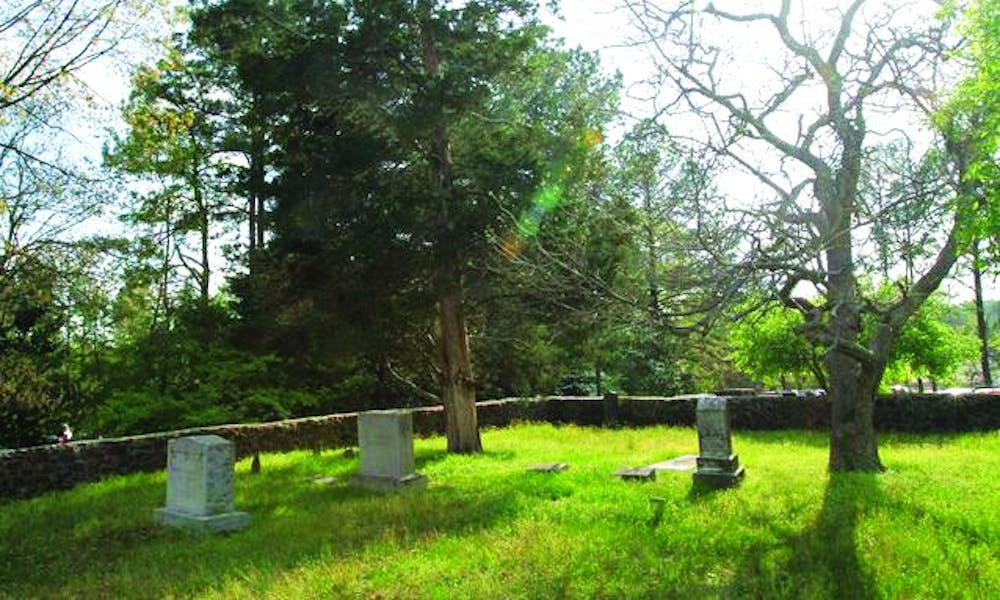“Although he sleeps, his memory doth live.”
These words are among the first things you see when you walk into T.J. Rigsbee Family Grave Yard—a three-foot tall tombstone with an epitaph remembering Thomas J. Rigsbee Jr., a member of the family that allowed the creation of Duke’s West Campus.
At the center of Blue Zone parking lot, less than 100 yards away from Wallace Wade Stadium, Rigsbee Grave Yard is easy enough to spot—that is, if you are searching for it. A three-foot high stone wall and steel gate encloses approximately 12 graves set around two small pine trees. While the grass is kept short and fresh flowers often sit near graves, erosion has taken a toll on several tombstones. Some markers, however, such as Rigsbee Jr.’s , which is decorated with engraved daisies, remain in near perfect form.
Its peaceful aura lives in stark contrast to the noisy chaotic scene around it—from cars whizzing by to hammers banging in Wallace Wade Stadium. As construction has enveloped West Campus, the graveyard is a remnant of Duke that will forever remain the same. Not only is Rigsbee Grave Yard the only piece of private property on campus, Duke’s administration and facility management recognize the historical significance of the cemetery.
“The Rigsbee Graveyard is sacred ground for the Rigsbee family and an important part of Duke’s history. It will continue to be protected as the campus develops,” said Michael Schoenfeld, vice president for public affairs and government relations.
The graveyard is not completely unusual. Georgetown’s campus features a Jesuit cemetery just off its main quad. Several other schools, including Notre Dame and Richmond, offer to have their alumni and faculty buried on campus for a fee ranging in the thousands.
And yet, the burial ground is eerily among the most unknown places on campus.
Questions about the background of Rigsbee Grave Yard initially lingered for a while after Duke’s founding. Although the Durham Sun first reported on the graveyard in 1938, a Chronicle article from Dec. 18, 1956 refers to the history behind the burial ground as a riddle and says “a partial answer has at last been found to the mystery surrounding the graveyard on the field east of the stadium.”
Two hundred years ago, the 200 acres, that now consist of Blue Zone and athletic fields and facilities, belonged to Jesse Rigsbee and his wife, Mary Rigsbee. The farmland and pasture was isolated inside the dense Duke forest, and the Rigsbee hog lot and barn stood near a ravine that is now Wallace Wade.
The Rigsbees were among Durham County’s most prosperous families—they helped organize Durham’s earliest schools and municipal government. Jesse Rigsbee ran a successful enterprise as a sweet potato farmer. One of his main specialties was storing potatoes during the winter, which he would then sell for seed in the spring.
Jesse and Mary had four daughters and four sons. All the sons fought for the Confederacy in the Civil War. Upon returning home from the war, one of their sons, Thomas Jefferson “T.J.”, expanded the family’s holdings, building a house where Duke Hospital now lies, and soon assumed responsibility for much of the family property.
Jesse first apportioned a quarter-acre plot of land to bury his eldest son, Henry Jackson “Jack,” who perished during the first year of the war. Soon after, according to family legend, he and his wife added three Confederate bodies—found in the nearby forest—to the newly formed graveyard.
Over the next 60 years, the burial ground became the Rigsbees’ official cemetery. Nancy Rigsbee, who died during childbirth and was Thomas’ first of three wives, was buried in 1880 under a flat stone. After Jesse and Mary joined her several years later, Thomas and his son, Thomas Jefferson Jr. were the last family members added to the graveyard in 1917 and 1924, respectively.
In 1929, the Duke family, neighbors of the Rigsbees, purchased approximately 600 acres of land from the heirs of the Rigsbee estate for $1,000. University archivist Vallerie Gillespie said that the Dukes purchased the land with the intention of expanding Trinity College into Duke University. There was not enough room on East Campus to expand, she noted. The land that the Dukes bought consisted of everything that is now West Campus and Duke Forest.
According to files currently in the University archives, James Buchanan Duke once sat on the stonewall surrounding the burial ground and unveiled his plans to build a Duke University to Thomas J. Rigsbee Jr.
But the Rigsbees had one condition for the sale of the property: the burial ground must remain untouched forever.
“The Rigsbee family shall have the right of ingress, ogress and regress over such part of said land as may be reasonably necessary for burying their dead and for maintaining, repairing and otherwise providing for the upkeep of said burying ground,” the deed reads.
Since then, descendants of the family have helped maintain the graveyard, mowing the lawn, removing weeds, brushing off tombstones and placing fresh flowers near the graves.
“The arrangement is that the family cares for the graveyard and maintains it as such, and the University provides them access to do so,” Gillespie wrote in an email.
And so Thomas Jefferson Rigsbee Jr.’s epitaph still applies today 92 years after his burial. Although students may not know it, T.J Rigsbee Grave Yard has watched over Duke West Campus since its birth. And don’t count for that to change anytime soon.
Get The Chronicle straight to your inbox
Signup for our weekly newsletter. Cancel at any time.

